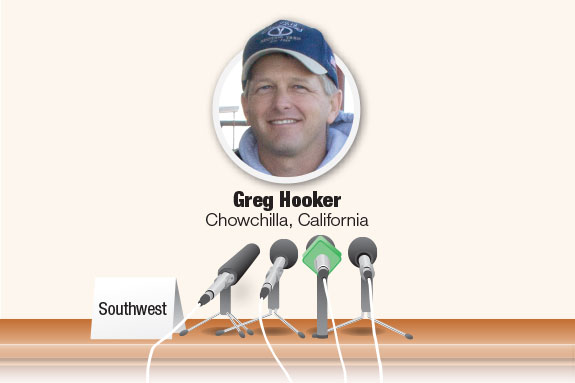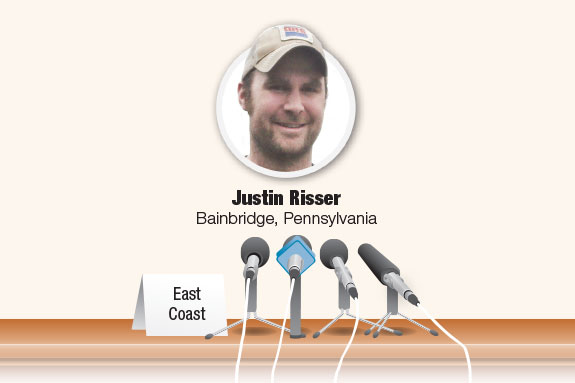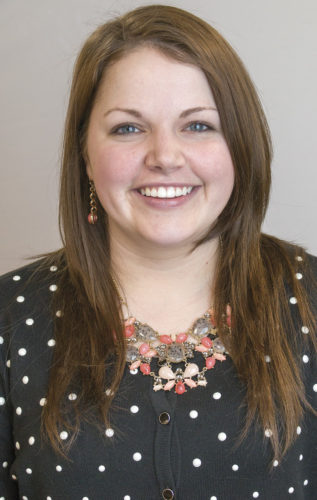In this new series of articles from Progressive Dairyman, three forward-thinking operations share protocols and lessons learned as well as what’s on the horizon. The first article in this series focuses on calf and heifer raising. Watch your mailboxes in 2013 for future discussions featuring A.I. and breeding decisions, feed and nutrition management and manure handling.
Our participants are:

• Greg Hooker of Diamond H Dairy in Chowchilla, California
This operation milks 4,500 cows and raises its own calves and heifers. The first half of the dairy was built in 2002. A new calf facility was constructed in 2009, along with the completion of the milking facility.

• Brian and Yogi Brown of Sunburst Dairy in Belleville, Wisconsin
The Browns are now milking about 500 cows after expanding twice since the 1990s. The operation was recently featured as part of Professional Dairy Producers of Wisconsin’s 100-Pound Dairy Facilities Tours. Yogi Brown oversees calf and heifer raising.

• Justin Risser of Meadow Vista Dairy in Bainbridge, Pennsylvania
The Risser family milks 750 cows in a double-16 herringbone parlor. Ownership of the farm now spans two generations with Justin, his father, Gerald; uncle, Don; and cousin, Eric.

Tell us about your calf and heifer program.
HOOKER: All animals including the calves and heifers are kept on this facility. The drop bull calves are sold at birth and picked up daily. The cows freshen in group pens. At birth the calves are ear tagged, given Calf Guard (just started this vaccine), given two quarts of colostrum, put in a temporary holding pen in the calving barn and then moved three times a day to our heifer-raising area.
Calves are fed twice per day in the hutches. They get two quarts per feeding until about 10 days and then receive three quarts per feeding until just before weaning. They have free-choice grain and water at all times.
BROWN: I raise about 300 wet heifer calves a year. Bull calves are sold to a local farmer within a week of birth. I try to keep things simple with the heifer program. I put a lot of energy into the first hour of a calf’s life. Everyone is trained and retrained on the proper procedure for newborn calves.
Immediately after birth, the calf is put in a well-bedded crate with a heat lamp. The navel is dipped completely and given Calf-Guard. After a half hour (but no longer than an hour) the calf is tubed one gallon of warmed colostrum/colostrum replacer. The calf receives a temporary paper leg band with the dam’s number written on the band.
When the calf is dry (within 18 hours), the calf is moved to an outside crate. Calf is ear-tagged, dehorned with dehorning paste and given Inforce.
Calves are on a high-pasteurized-milk program. They are offered a 22 percent starter and always have warm water. They are weaned at about 6 weeks and moved into small groups of no more than five. The calves are started on grass hay and an 18 percent starter. Waterers are cleaned every five days.
Calves are introduced to headlocks at three months. They are vaccinated at four months with pinkeye vaccine, Bovishield and Vision 7. This is repeated in three weeks.
Calves go to an open lot at 5 months where they are introduced to TMR. At 7 to 8 months, calves are sent to two heifer growers and returned two months prior to calving.
RISSER: We raise 350 to 375 wet calves each year. We feed our wet calves pasteurized waste milk twice daily with an amount of three quarts each time.
We start the weaning process at 4 weeks and, by 5 weeks, the calves are completely off of milk. We feed a starter that is a custom mix of a molasses-coated pellet with steam-flaked corn. Rumensin is formulated into the starter. We vaccinate our calves for E. coli, clostridium and rota-corona virus at birth. Calves are born on a bedded pack that is bedded with kiln-dried sawdust.

How do you manage colostrum?
HOOKER: The colostrum each calf receives is collected three times per day from the most recent fresh cows. It is collected and graded by the calf feeders and those responsible for monitoring the calving barn. It is preserved with potassium sorbate and stored in the refrigerator until needed.
Random calves are selected twice per month to measure for IGGs. Those responsible for giving newborns the colostrum receive a bonus if all calves have sufficient levels.
BROWN: Colostrum is harvested three times a day when the fresh pen is milked. It is transferred from a clean catch bucket into “Udder Perfect” bags which are labeled with dam’s number and date collected. Colostrum is discarded if not used within five days. Colostrum is put in the refrigerator immediately after harvesting.
As calves are born, the colostrum bag is warmed in a pail of warm water. The bag is discarded and only the feeding tube needs to be sanitized.
RISSER: High-quality colostrum is kept for all heifer calves. We test colostrum with a refractometer and only keep exceptional colostrum for heifers. Greater than 25 percent solids is what we are looking for. We refrigerate 85 to 90 percent of our colostrum.
We recently started pre-chilling it in a bucket with three soda bottles frozen with water. This allows us to drop the colostrum temperature from near 100ºF to under 50ºF in 45 minutes to an hour. For feeding purposes, we feed three quarts as rapidly as possible and don’t follow up later.
Since we have colostrum ready in the refrigerator, this allows for rapid warming and feeding, usually within two hours. We’ve checked total protein on our calves and we usually run over 6.0 with many approaching 6.5 or higher.

How are your calves housed?
HOOKER: At the beginning we housed our calves in typical California-style wooden hutches on an extra cement flush lane meant for the second half of the dairy. As we continued to build the remaining half of the dairy, the calves grew in numbers and were eventually pushed off of the cement onto the dirt. Looking back, the calves did reasonably but the system was labor-intensive and it seemed we struggled with more disease issues.
As we finished the milking facility we also finished our new calf-raising facility in 2009. It uses the same wooden hutches sitting on concrete curbs with a fresh water flush. The drive lanes are also concrete but the area behind the hutches is dirt, so the calves have sufficient footing when we remove them after weaning.
We have a 600-head capacity. We move about 225 calves through this system each month, which amounts to about a 70-day stay for each calf.
Right now the calf area is not covered and with our mild climate here this has not been too much of a problem. We have considered putting up some type of shade structure over this area because we can have some problems during the summer when the temperature is over 100ºF.
BROWN: Wet calves are housed in individual Calf-Tel crates which are set on a deep gravel pad. At 2 to 3 months, calves are housed in an open-front building with bedded pack in small groups. At 4 to 5 months, they’re introduced to headlocks on a bedded pack with larger group numbers. At 6 to 8 months, they’re on open pasture and small freestalls.
Two years ago, I added tube ventilation in the open-front pens. This keeps the air fresher and the bedding drier. This helped reduce pneumonia. I also redesigned the headlock/bunk area, twice. I now hand-feed hay to the young calves on a daily basis. This has cut wasted hay in half. Getting the bunk height correct so the headlocks would self-lock took a bit of adjusting but is working well now.
RISSER: We house our calves in two 42-stall open-front barns. The stalls are divided with poly dividers and this makes for easy cleaning and sanitation. We pressure wash each stall after every calf. We bed our calves with sawdust and sometimes chopped straw in cold snaps.
What we have found is that we shoot to have stalls sit for two weeks to dry and allow sunlight to do its job on bacterial load after washing. When slugs hit, nothing beats time between calves for that individual stall. When we have emptied a stall, cleaned it and put a new calf right back in, we experienced more health issues in our calves.

What have been some of your challenges or successes with bedding for your calves?
HOOKER: We use no bedding in our hutches. The floor is made up of wooden slats. After weaning, they are moved to group pens, initially of about 30 and eventually of about 200 as they approach the age of 8 months. The pens are typically sloped drylots with a flushed feed lane and lockups.
The heifers have a shade until about six months, then they go to just open lots until they are about 230 days carried calf (dcc) and then they are moved back to a corral with shades again.
BROWN: I never liked straw in the crates in the summer. It attracts too many flies and is difficult to keep dry. I now use sand in the crates from May to October. Crates are bedded with a sand shooter just once. The crate is not cleaned until the calf is moved to the next group.
The used sand is used to bed the 2-month-old to 3-month-old calves in the open-face shed. This not only saves much bedding – the flies are greatly reduced and labor for bedding these groups is next to nothing, instead of two to five hours per week.
RISSER: We tried sand in the calving pen but had fresh cow issues with some of the dams after they ingested several pounds of sand from licking the calf dry. Since then, we’ve used sawdust on a regular basis.
We dip navels with iodine at birth to help ensure the navel dries up. A clean, dry calving pen in conjunction with iodine has kept our navel infection rate at bay.

What is your feeding strategy for the winter months?
HOOKER: We don’t feed much differently during the winter months. About the only thing we do a little differently during the winter is to place our newborns under an infrared heater until they are completely dry after birth. We add a balancer to our waste milk year-round to increase the solids slightly.
During the summer heat we simply make sure all calves have plenty of water all of the time. We will give scouring calves some extra water with electrolytes in a bottle between milk feedings at times.
BROWN: Wet calves are fed the same year-round – pasteurized milk at up to three gallons fed over two feedings. Warm water is fed twice a day as much as the calf wants to drink. Calves that are weaned get the grain mixture increased by ¼- to ½-pound per day from December to March.
RISSER: In the winter we do feed a little more milk when it’s extremely cold. One thing we do starting in December is adjust our pasteurizer’s output temperature for pasteurized milk. We normally have it at 105ºF so it’s 95ºF to 98ºF at the calf. In the winter with rapid cooling in the open-front barns, we adjust it up to 115ºF to make it more palatable to the calves.

What is one new technology or product you’re looking to implement into your calf-raising and heifer-raising program in the next year?
HOOKER: We have been fairly successful at keeping calves alive (about a 3.5 percent death loss since 2009), but we could do better at reducing our treatment costs and do a little better in our daily gains. We are currently looking at our vaccination program to see if we can reduce some sickness events therefore lowering treatment costs (we just added a Calf Guard vaccine and we’re considering Inforce3).
We currently pasteurize our waste milk for the calves but are considering getting a pasteurizer for our colostrum as well.
Overall, we are looking for ways to get these animals in the barn quicker. A healthy calf grows faster; we can aggressively breed her when she has the right size and get here in the barn making milk as soon as possible.
The herd replacement costs have become more and more significant, especially because the cost of feed has increased. As we and the calf ranches have become pretty good at keeping the calf alive, we can focus more on driving down the costs to get these heifers in the milking barn.
BROWN: In the past, I have always burned horns at 3 to 6 weeks old. This worked well except in winter, when the weather can make this challenging in outside hutches. I began in June using dehorning paste and am having good results.
The paste is applied within 18 hours of birth by first clipping all hair on the horn bud area, applying paste and covering the area with Gorilla duct tape for about six hours. I think this is less stressful on the calf than burning.
RISSER: We’ve started monitoring our colostrum and pasteurized milk monthly for standard plate counts. When we DHIA test, we’ve started to send some samples to keep on top of things, make sure nothing slips in procedure. Our goal is <10,000 col per mL for pasteurized milk and <50,000 col per mL for colostrum.
We also are testing our waste milk monthly to get a baseline of what amount of solids our calves are getting. This is in the infant stage but we’d like to shoot for 16 percent solids on a consistent basis to promote rapid growth and weight gain. PD







